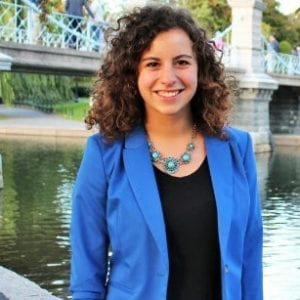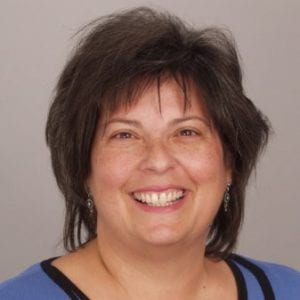Since the onset of the Covid-19 pandemic, the hiring process has undergone a radical change, both for recruiters and job hunters. The job market has been reshaped as some sectors, like travel and tourism, have shrunk and others, like online services, have exploded. The unemployment rate remains high. And the talent acquisition pipeline has gone viral – most interviewing is now done online.
 Our panelists approached the digital transformation of the hiring process from very different angles. Stephanie Baysinger, CPS’15, is the Head of Recruiting Operations at Klaviyo, a rapidly growing digital marketing company. Her team of recruiters currently reviews thousands of applications for 200 job openings in the company.
Our panelists approached the digital transformation of the hiring process from very different angles. Stephanie Baysinger, CPS’15, is the Head of Recruiting Operations at Klaviyo, a rapidly growing digital marketing company. Her team of recruiters currently reviews thousands of applications for 200 job openings in the company.

Two other alumni brought the job hunter’s perspective to the discussion. Laura Setton, CPS’20, graduaed from our Corporate and Organizational Communication master’s program and recently joined Avid, a media technology company, as an Employee Communications Specialist.
 Talha Khan, CPS’20, who focused on Public Relations during his course of study, is currently engaged in a job search. Talha was a key member of the student team that designed and launched our Husky Communications website last summer.
Talha Khan, CPS’20, who focused on Public Relations during his course of study, is currently engaged in a job search. Talha was a key member of the student team that designed and launched our Husky Communications website last summer.
 Ellen Zold Goldman, a member of the team that provides a wide range of career resources and services for Northeastern students and alumni, has personally coached scores of students in their job searches.
Ellen Zold Goldman, a member of the team that provides a wide range of career resources and services for Northeastern students and alumni, has personally coached scores of students in their job searches.
Here are some of their suggestions for successfully navigating the ‘new normal’ of the hiring process.
How to prepare for virtual interviews
Ellen: Employers are using different platforms to conduct the job search process, so you want to make sure you know what platform you’re going to be on, and, if possible, practice on that platform ahead of time. I recently worked with a student who ended up accepting a position at Facebook, and she realized that she had to position her laptop in a certain way to come across effectively in her interviews. Figuring that out ahead of time reduced the stress factor considerably.
Stephanie: I agree with Ellen. The job candidate should feel free to ask the recruiter what technology they will be using, whether there will be breaks in the interview schedule, etc. The fact is that the recruiters and hiring managers are facing the same virtual challenges as the job candidates. The goal really is for everyone to feel comfortable in the give-and-take of an interview. Another piece of advice is to learn as much as you can about the organization and its culture. Use resources like Glassdoor.
Laura: For me the virtual interview process was quite exhausting. It was kind of the opposite of what you would expect in person where you go and have a structured day, meeting different teams, and then it’s done. Instead, the virtual interview process extended over several days, which was stressful and I had to constantly refresh myself. But it also allowed me to pause and think about points in one conversation that I could bring up in the next one. I had ready-made talking points that I could bring up in the conversation, showing that I could bring value to the organization. So there are definite pluses and minuses to interviewing virtually. And, yes, I second Stephanie’s suggestion to use Glassdoor!
Talha: In some job searches, you will be asked to record a brief video response to a question like “why do you want to work here?” It sounds easy, but it really isn’t! Saying that you want to make a contribution to the organization’s performance is not enough. You have to convey a sense of the organization’s values and how those align with your own.
Another question where you feel like you can easily go off on a tangent is “Tell me about something you’ve accomplished that you’re proud of?” This can be a challenging question for those of us without a lot of professional experience. And this is where the experiential consulting projects I worked on during my studies at Northeastern are really valuable – I can point to specific project outcomes.
Stephanie: To follow-up on Talha’s last point, I recommend the PSLR framework to prepare for that question. Think about some of your best accomplishments. And then practice responding using the PSLR framework: What was the problem, what was the solution you came up with, what did you learn in the process, and what were the results.
Why culture matters, especially as it relates to diversity and inclusion
Talha: If you want to know what an organization is doing with regard to DEI, you can obviously look at their website, you can see who is on their leadership team. But during the interview process, you can take it a step further and ask the interviewer what specific steps the organization has taken to support these initiatives. If the organization is not just engaging in lip service, the interviewer will be able to articulate the strategy and what actions are being taken to promote diversity and inclusion.
Stephanie: From the hiring perspective, we’ve gone beyond relying on the usual filtering mechanisms to expand the diversity of the talent pool. In addition to reviewing resumes, our recruiters are building connections through social networks They spend almost half their time checking out LinkedIn profiles and other social networks, for example. This helps us expand the range of candidates who might be a good addition to the company.
Laura: International students can face a distinctive challenge in the job search process: Do companies have a culture of sponsoring international employees? If they do, it shows me that they value attracting strong job candidates even though there is more paperwork involved in doing so. If they don’t have a sponsorship track record, it helps me narrow my job search.
Why your presence on social networks is so critical
Stephanie: As I mentioned earlier, our recruiters supplement their review of resumes by looking at candidate LinkedIn profiles. Make sure that your profile is up-to-date and that it conveys the competencies and skills in demand by the organizations you are applying to. If you are applying for digital marketing positions, for example, you should highlight the digital marketing experiential projects you’ve worked on during your course of study.
Ellen: That’s great advice. If you are seeking a professional position, you simply must have a presence on LinkedIn. Be sure to display any digital badges that you’ve earned in your courses and include a link to your ePortfolio. We offer two coaching labs on how to leverage LinkedIn, so take advantage of that as well.
Talha: I’m a firm believer in networking! I reach out to people in my network, tell them that I’m an aspiring PR professional, and ask for their advice. Most of the time, they reach back to me and we’ll schedule a call. Whether or not it results in a job opportunity, these informational interviews are great learning experiences and help me fine tune my interviewing skills.
How to be versatile and authentic at the same time
Ellen: When you prepare for interviews, you need to be your authentic self! Don’t worry about over-memorizing your responses to possible questions. That comes across as a canned response. Instead, anticipate questions, practice your answers, and prepare, but make sure you allow the interviewer to see your passion – even if it’s on a Zoom call. You want to be able to effectively tell your story in an authentic way and connect your examples to the position. Be sure to check out our coaching labs including Interviewing with Confidence, take advantage of Big Interview via NUworks, and do mock practice interviews through the Career Studio with Career Design. Explain what is it about the organization that connects with you.
Laura: You also have to be aware of your own and the interviewer’s communication styles, especially if you’re from a different culture. I’m originally from Brazil, and it’s taken me time to adapt to the more reserved American style of communicating. Here’s another example. I spent some time working in Poland and soon learned that asking people “how’s it going?” was received very differently there than it would be in the U.S. Here, it’s a way to say ‘hello.’ In Poland, it’s an invitation to engage in a lengthy conversation. So, being aware of different communication styles is important. But I agree with Ellen, you also have to go with your authentic persona.
Posted by Carl Zangerl, Faculty
Career Design resources for Northeastern students:
- NUworks for jobs postings since these employers are seeking out Northeastern students.
- Weekly schedule of events.
- For information about interviewing, click here.
- Resources for international students and those seeking diverse work environments.
- Click here for a list of staffing agencies